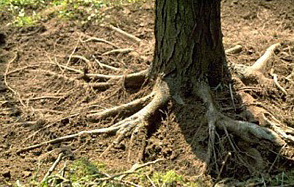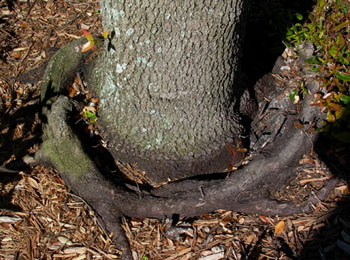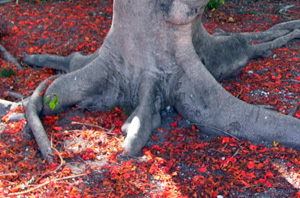Home > Root growth > Root collar exam and treatments > Remove circling roots
Remove circling roots
 See: more on girdling roots and treatments.
See: more on girdling roots and treatments.
Trees with roots that are touching or circling the trunk (right photo) instead of growing straight away from the trunk (left photo) stress the tree by reducing or eliminating vascular flow where the root contacts the trunk. Stress increases with time and can lead to dead spots on the trunk and tree decline. When the root defect is minimal
then nothing needs to be done; but trunk girdling, dead patches on the trunk, and tree death could occur when
the defect is serious. Your evaluation of the situation will determine
if root severing will help the tree in the long run compared to the stress caused
by cutting the root. The problem is caused by the fact that in most cases roots do not graft to trunk tissue.
The problem is caused by the fact that in most cases roots do not graft to trunk tissue.
Some of this can be corrected by removing the root defect, but root removal also stresses the tree. Stress from root removal will only last for a relatively short period and will decrease with time as the tree recovers from the lose of the root. Leaving the root defect in place can increase stress with time. If the cambium has not been permanently damaged where the root touched the trunk then normal vascular flow could return following root removal. Irrigation management during this recovery time is likely to reduce stress and help the tree recover. You must judge whether eliminating stress by removing the defect outweighs the temporary increase in stress brought on by root removal. Typically, removing the defect is best for the tree provided less than about 30% of the root system was removed with root pruning cuts. In separate research projects, Watson (with pin oaks) and Gilman (with live oaks) showed that 25% of the roots can be removed without impacting the appearance of the tree. Some arborists are experimenting with removing more than 30% of the root system.
Removing or cutting roots that circle or touch the trunk (upper right photo) or cross over (lower left photo) main roots can improve tree health in certain circumstances. First, carefully remove the soil from around the base of the trunk so you can see the root flare. Then, make clean pruning cuts back to a lateral root if practical.
 Certain species such a magnolia, maple, hollies, mahogany, black olive and others appear especially sensitive to this defect; however, any tree can be affected by circling or stem girdling roots. Some arborists routinely remove roots that might be as large as one-quarter of the trunk diameter, or even larger. Cut roots at the
point where they begin to circle so new roots that grow from the cut will point
away from the trunk. New roots will grow more-or-less parallel to the direction
of the root section just behind the cut, but some could grow in as much as a 90 degree angle to the cut.
Certain species such a magnolia, maple, hollies, mahogany, black olive and others appear especially sensitive to this defect; however, any tree can be affected by circling or stem girdling roots. Some arborists routinely remove roots that might be as large as one-quarter of the trunk diameter, or even larger. Cut roots at the
point where they begin to circle so new roots that grow from the cut will point
away from the trunk. New roots will grow more-or-less parallel to the direction
of the root section just behind the cut, but some could grow in as much as a 90 degree angle to the cut.
| GUIDELINES FOR REMOVING POTENTIAL GIRDLING ROOTS | |
| Situation | Solution |
| root circles < 1/4 the trunk and is easy to remove | remove it |
| root circles < 1/4 the trunk but is difficult to remove without injuring the trunk | cut it, but don't remove it |
| root crosses over main root | cut or remove it |
| root circles >1/4 the trunk | cut or remove it |
Here are some additional thoughts. If the defective root circles more than half the trunk diameter and is embedded into the tree give careful consideration to whether removal will help the tree. Some defects are so severe that removal may not be possible; or the defect might have already killed the cambium on that side of the tree. Check by carefully penetrating the trunk tissue just above the root defect to see if the tissue is green or brown. If you find no live green tissue on a large portion of the circumference of the trunk then that portion of the trunk is dead and treatment may be futile.
Do not remove the portion of a circling or crossed root that is deeply embedded or grafted to the trunk. Occurrance of roots grafting to trunks is not well understood but at least some arborists report that grafting is uncommon or rare. Leave any portion of the root that is embedded in the trunk if removal will severely injure the trunk. When roots are completely circling
the trunk (above right photo) then treatment may not be practical. Circling roots near the soil
surface are more of a concern than those that are deeper. Always consider irrigation for a period of weeks (for small
trees) or months (for larger trees) as a follow up treatment to root severing, especially in drought or dry soils.
Root severing on mature trees may cause more harm than good.

